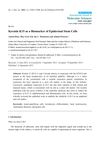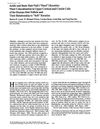Equine Hoof Stratum Internum K14+CD105+ Progenitor Cells: Culture, Characterization, and Model of Epithelial to Mesenchymal Transition
October 2019
TLDR Equine hoof progenitor cells can help develop therapies for hoof diseases like laminitis.
The study investigated equine hoof progenitor cells, particularly K14+CD105+ cells, to understand their role in hoof tissue formation and potential in cell-based therapies for laminitis. Researchers isolated and characterized progenitor cells from fresh and cryopreserved equine laminae, finding that these cells have multilineage differentiation capacity and exhibit different behaviors based on preharvest and postharvest conditions. K14+CD105+ progenitor cells demonstrated a stronger proliferation rate and higher epithelial to mesenchymal transition (EMT) marker expression, suggesting enhanced cell plasticity. Inflammatory cytokines were found to increase EMT protein expression, indicating their role in promoting EMT. The findings provided insights into hoof cell composition and informed future progenitor cell-based tissue engineering approaches for hoof disease prevention.



